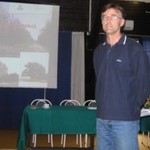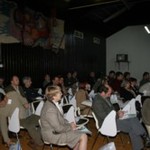A Gipsy Moth Workshop is Serbia
Chemtura held its 2nd International Gipsy Moth Conference in Donji Milanovac (Serbia) along the banks of river Danube, near the Iron Gate, 15th through 18th November 2006.
Hotel Lepenski Vir, situated against a picturesque setting, put up the conference as well as its attendants from seven countries, the latter representing sylvicultural organizations and National Parks of their respective homelands.
 For all co-authors (including György Csóka, Anikó Hirka, László Kondár, Zoltán Stubán, and Szabolcs Varga), Dr László Kondár delivered the presentation of the Hungarian section.
For all co-authors (including György Csóka, Anikó Hirka, László Kondár, Zoltán Stubán, and Szabolcs Varga), Dr László Kondár delivered the presentation of the Hungarian section.
Giving a comprehensive account of exuberance and control of gipsy moths in Hungary, this presentation touched upon control efforts made in Bakony Hills most stricken by the damage of the pest, costs and joint experimental developments related thereto as well as the role media had played and how the community had been kept informed.
In his introduction, the lecturer made reference to the two millionth hectare of forest recently declared as planted, and the current goal being a 26-27 percent ratio of wodlands in Hungary.
A well-know fact, gipsy moth had been indigenous in Eurasia, and transferred to the United States in 1869. Throughout Europe, multiple countries were affected by damage of the pest, with, among others, a total of 500,000 to 600,000 hectares stricken in Romania, 405,525 hectares in Serbia, 100,000 hectares in Croatia, and 200,000 hectares in Spain.
In Hungary, 4000 hectares had been affected annually on an average of 41 years. Peaks of exuberance had occurred in 1966 and 2002. Exuberance occurred every five years on the average, not always being capable of asserting itself, but usually promoted by rainless weather.
Using a silk thread it produced, the caterpillar of gipsy moth was able to cover a distance as long as 40 kms by a single flight, carrying infestation over to far-away locations. Based on mass-of-eggs counts, three categories were used in Hungary to measure intensities of attack: low intensity being marked by less than 500 masses of eggs as counted within a 0.1-hectare area; medium intensity by 500 to 1000 masses of eggs; and high intensity by 1000 plus masses of eggs, respectively. Each 1 cm2 of a mass contained about 70 eggs.
As well as oaks, gipsy moth did damage to pines save for larch.
Generally, an exuberance of gipsy moths caused damage over a period of four months, and that was why environmentally sound chemicals with long persistence were used for control.
Unlike in Serbia where the best results had been achieved through the use of aircraft, helicopters were used to apply chemicals in Hungary.
The so-called ULV (Ultra Low Volume) technology, a rather economical and environment-friendly method, had not been permitted in Hungary yet.
BT (Bacillus thuringiensis) products, a means of biological control, had been applied to top-priority conservation areas. Because of high intensity of infestation, such products should have been applied at double rates or repeatedly. Furthemore, they could be applied in late afternoon hours only, when flight time was limited. Accordingly, such products would have required a total flight capacity about eight times as high as available currently. Proximity of residential areas to lands to be treated caused another problem. All in all, a lot of factors of uncertainty existed here, with an additional shortage of governmental finances granted.
Consequently, Dimilin (diflubenzurone), a chitin-synthesis inhibitor, had mainly been used.
Government subsidies granted for control efforts were different in their measures, with regions most frequented by tourists enjoying 100 percent support, sensitive woodlands and nature reserves being granted subsidization to an extent of 50 percent to prevent a chain of damages, and other forests being granted no subsidy at all.
Very importantly, poor control would prolong exuberance.
It was also mentioned that negotiations with WHO and FAO on usage of Dimilin for mosquito larvae control were at an advanced stage.
 Mr Sámuel Almásy (Serbia) made mention of the fact that any usage of chemicals would upset the balance between pests and useful organisms.
Mr Sámuel Almásy (Serbia) made mention of the fact that any usage of chemicals would upset the balance between pests and useful organisms.
Dimilin decomposed in 1 to 7 days, and did not build up. When applied by means of the ULV technology, it was used at a rate of 3 Litres per hectare (with a droplet size of 80-120 microns). The active substance could be used at a low rate thanks to the fact that it was 'glued', as it were, onto the surface of leaves, hence unable to be washed off by rain, through the action of an oil additive.
Applied to L2 instar larvae after they had cast their skins, Dimilin would inhibit synthesis of chitin. Consequently, while a larva was feeding voraciously, its skins would not grow, causing the pest to explode practically.
 Mr Boris Lyovich (Forestry Research Institute, Croatia) reported that damage done by gipsy moth had been observed on Adriatic Islands too, with the highest levels of exuberance having occurred in 1999 and 2005. Lymantria dispar had damaged a total area of nearly 40,000 hectares.
Mr Boris Lyovich (Forestry Research Institute, Croatia) reported that damage done by gipsy moth had been observed on Adriatic Islands too, with the highest levels of exuberance having occurred in 1999 and 2005. Lymantria dispar had damaged a total area of nearly 40,000 hectares.
Small areas had then been treated with a pyretroid. Dimilin had been applied to 40 percent, and BT products to 22 percent, of the total area damaged.
Subsidies granted to control efforts were rather low in Croatia.




